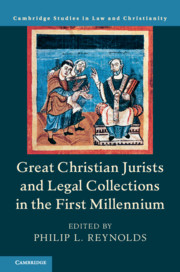Book contents
- Great Christian Jurists and Legal Collections in the First Millennium
- Law and Christianity
- Great Christian Jurists and Legal Collections in the First Millennium
- Copyright page
- Contents
- Contributors
- Preface and Acknowledgments
- Abbreviations
- Part I
- Part II
- 10 Lactantius
- 11 Ambrosiaster
- 12 Augustine of Hippo
- 13 Leo the Great
- 14 Gelasius I
- 15 Dionysius Exiguus
- 16 Benedict’s Rule
- 17 Gregory the Great
- 18 Isidore of Seville
- 19 Pseudo-Isidorus Mercator
- 20 Jonas of Orléans
- 21 Hincmar of Reims
- 22 Regino of Prüm
- 23 Burchard of Worms
- 24 New Horizons in Church Law
- Index
- References
22 - Regino of Prüm
from Part II
Published online by Cambridge University Press: 21 June 2019
- Great Christian Jurists and Legal Collections in the First Millennium
- Law and Christianity
- Great Christian Jurists and Legal Collections in the First Millennium
- Copyright page
- Contents
- Contributors
- Preface and Acknowledgments
- Abbreviations
- Part I
- Part II
- 10 Lactantius
- 11 Ambrosiaster
- 12 Augustine of Hippo
- 13 Leo the Great
- 14 Gelasius I
- 15 Dionysius Exiguus
- 16 Benedict’s Rule
- 17 Gregory the Great
- 18 Isidore of Seville
- 19 Pseudo-Isidorus Mercator
- 20 Jonas of Orléans
- 21 Hincmar of Reims
- 22 Regino of Prüm
- 23 Burchard of Worms
- 24 New Horizons in Church Law
- Index
- References
Summary
The Libri duo by Regino of Prüm (d. 915) was a handbook for bishops and other clerics to use in pastoral work and in teaching. The Libri duo gives detailed instructions for episcopal visitations, when a bishop would visit the parishes of his diocese, adjudicating offenses committed there. The collection includes penitential material as well as canon law, but these modern categories do not map neatly onto the lived experiences of Carolingian bishops. The Libri duo not only addresses the correction of offenses but also provides instructions for ritual practice and church administration. Regino may have manufactured or “forged” some of his canons, since they appear here for the first time. But, as Wilfried Hartmann has suggested, he may have drawn upon less familiar canonical sources, such as episcopal capitularies; or, as Sarah Hamilton has proposed, he may have been describing contemporaneous practices. Although the collection enjoyed only limited circulation, Burchard of Worms used it as a source of material and as a model for his popular Decretum.
Keywords
- Type
- Chapter
- Information
- Publisher: Cambridge University PressPrint publication year: 2019

